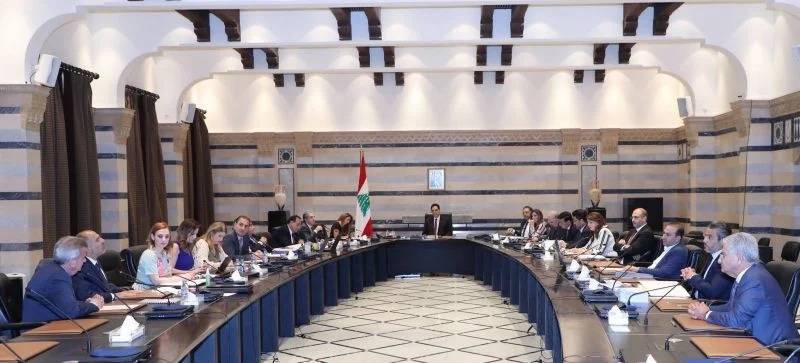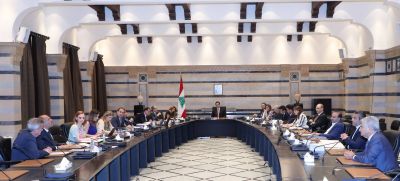
Riad Salameh and Salim Sfeir participate in a cabinet session led by Hassan Diab in July 2020. (Credit: Dalati and Nohra)
Observers may be reminded of early May 2020, when the ABL headed a movement, including a large part of the political class and Banque Du Liban, that torpedoed the rescue plan proposed by Hassan Diab’s cabinet.
Two years later, the language used by the banking lobby — which claims that it was neither consulted about nor knowledgeable of the plan’s “hypothetical” details — in its the response [to the plan], shared with Reuters Monday, remained unchanged: it objects to the assessment of what it describes as “so-called losses” and blames “successive governments” for being mostly responsible for the crisis.
The similarities end here. First, this time it is the IMF that has called on the government to revisit its plan; second, and most importantly, this unshakable position indicates that other actors in a once-united front, starting with BDL governor Riad Salameh, now stand in a different place.
While Salameh has yet to comment publicly on the government plan — even before it was presented to the IMF, the BDL governor had submitted an alternative draft, the major points of which L'Orient-Le Jour learned — he is not quite in the same boat as the ABL.
Unlike a year and a half ago, this time Salameh is sitting at the negotiating table with the IMF, having agreed beforehand with the ministerial committee assigned to follow up on the talks concerning the size of the financial system’s losses a deficit of about $69 billion, including $48 billion in losses incurred by BDL, Deputy Prime Minister Saade Chami said in December.
‘Obsequious compliance’
It was on this point in particular that the “banks’ party” based its full-scale attack on Diab’s plan. Back then, BDL said that it would be able to gradually amortize its losses — which are hidden in its balance sheet as “other assets” — against future revenues. ABL, meanwhile, had insisted that the Lebanese banking sector is in no need of a bail out. Their main objective was to form a joint front against a state that is accused of accumulating deficits, squandering money borrowed from the banks and deciding in March 2020 to default on its foreign debt — a decision that BDL and ABL fiercely opposed.
“Since then, BDL has been coerced to acknowledge its losses and to adopt international accounting standards within the framework of the financial audit conducted by Oliver Wyman. It is now seeking to allocate these losses, and it will not hesitate to close banks if necessary. For its part, ABL is in a state of uncertainty: its May 2020 plan fell through and, faced with the new reality, it mainly seeks guarantees for safeguarding the sector,” a source with knowledge of the dossier said.
Neither ABL nor BDL replied to L’Orient-Le Jour’s inquiries.
“The two institutions did not have the same interests at all times,” said another source who, like all those interviewed for this story, preferred to remain anonymous. “Up until now, the best strategy of the two actors has been to stand united against the state.”
That said, several months earlier many professionals in the sector had started to question some monetary policy choices, including long-established ones, and more generally the way Salameh has managed the crisis.
“Officially, bankers have always been compelled to obsequiously comply. But privately, many whispered their opposition,” said one of their regular interlocutors.
When it comes to official communications, the once-perfect couple has shown discreet signs of frustration with each other.
For instance, ABL secretary-general Makram Sader admitted, in an Al-Markaziya article published on Jan. 3, that the bulk of the banking system’s losses come from investments with BDL (which consist of 82 percent of deposits, according to its September 2021 balance sheet).
“It is an obvious conclusion that has not been mentioned, in an effort to protect their image,” a banking source said.
Previously, ABL was ambiguous about BDL’s losses, as it included them as part of the state’s losses. “The finger is being pointed at BDL’s responsibility now in a clearer way,” said one of the anonymous sources.
“Since BDL suffered losses by lending the money to the state in an indiscriminate way, it is therefore the one that must shoulder [these losses], not to the banks, which are its creditors,” said a manager of a major bank.
Why, then, did the banks join the game by heavily financing the state and BDL in foreign currency using their depositors’ savings? The banks claim they had no other choice.
“All the Lebanese commercial banks were affected, which shows that it is a systemic issue, rather than a management-related issue in every bank,” a banking source said.
“It’s BDL that lays down the rules of the game. It is ultimately the one who decides where we must invest our funds,” said another banking source.
In the aforementioned article, Sader indicated that various BDL circulars issued from 1993 to 2021 limit the possibility of non-domestic investments.
Many other bankers claim that they took part in BDL’s infamous “financial engineering” — which offered banks incentives to invest their cash with BDL in exchange for stupendous interest rates — because they lacked any other choice.
“BDL is the one who approached us, while most of us tried to convince it to not follow this policy. Had a particular establishment decided not to join, it would have taken itself out of the game, because the depositors would go to the highest bidder,” a bank manager said, adding that,“These operations [that required us to refrain from distributing the profits made in Lebanese lira to shareholders so as to contain inflation] were mainly good for the BDL,” the manager added.
The first operation allowed participating banks to pile up $5 billion in revenues in 2016, or “the equivalent of 10 percent of the GDP, without any equity stake in return,” the IMF reported in 2017.
The annual reports of some of the participating banks clearly reveal that dividends significantly increased that year, despite the moribund economic environment.
“Some capitalized on that to elevate their dividend payout ratio. Profits also increased thanks to the influx of deposits from the region,” a banking source justified.
The last argument of this informal innocence plea concerns the key role Salameh played: “The central bank is not a debtor like any other. It is the one who regulates the sector and can make any bank’s life impossible, bringing us into subjugation,” a banker said.
Article 208 of the Code of Money and Credit grants BDL many powers: In some cases, it is entitled to set up administrative measures, allowing it to limit or suspend credit facilities, prevent certain transactions and even remove an institution from the list of officially recognized banks.
“Even without resorting to these provisions, the governor has significant deterrent power, as director of the special investigation committee or president of the Capital Markets Authority, for example,” added an observer.
It still holds true that if BDL’s wide powers could deter individual banks, “ABL could have taken a stance as an institution and condemned the financial engineering,” said a banker who is also critical of ABL.
Mutual protection
The system in place seemed to benefit all the main actors: The political class, to whom it gave the means to postpone reforms; the economic elite, who benefited from very attractive rates of return; bankers, who were able to expand the size of their balance sheets and increase their profits; and BDL which managed to get bailouts.
With the economic collapse, however, this convergence of interests is no longer so clear. In its latest press release, ABL called on the government to propose a plan that does not “save the future of the politicians who led the country into the current unprecedented crisis in the history of Lebanon,” by explicitly mentioning the approaching “deadline of the parliamentary elections.”
Was this a jab at Salameh as well?
“He is, above all, the protector of the political class,” said a source interviewed for this story, who agreed with many bankers who believe that BDL’s decisions are now made at their expense.
For example, the current policy of injecting dollars into the market via the Sayrafa platform in order to “save time” no longer works.
“A few months out from the elections, the electoral goal is clear. BDL’s meager reserves, some $13 billion, that is to say essentially depositors’ money, are being squandered for clientelist purposes,” said one banker.
Moreover, this relationship of protection is reciprocal: while the Aounist camp seems to have prioritized the need to replace Salameh — seen as a symbol of the Hariri era — the latter has always benefited from the unfailing support of most of the other political stakeholders, starting with Lebanon’s past prime ministers, including Tammam Salam, Saad Hariri, Fouad Siniora, and Najib Mikati, not to mention Nabih Berri and other sectarian leaders.
This support did not cease even in the spring of 2020 when then-premier Diab decided to speak publicly about his disagreement with the “monetary policies that are decided behind the scenes,” without practical effect.
This support was also confirmed in the past months, when Mikati said during a press conference at the end of December that “one does not change their officers during a war,” referring to Salameh who was then embroiled in international investigations into his personal fortune.
As for the banks’ lobby’s support for Salameh, nothing suggests that it is definitively compromised. The hard-line wing of banking interests has good reason to protect its precious ally in the face of the challenges to come.
“The alternative plan concocted by Salameh relied much on ‘lirafication’ (which affects more than 70 percent of deposits). While the banks are officially against it — since it is done at the expense of their customers — they believe this process helps clean up their balance sheets and rids them of deposits due in dollars,” an informed source told L’Orient-Le Jour.
“We knew from the start that the IMF finds this strategy to be dangerous,” the source added. “It is even possible that in reality, neither Salameh nor most of the shareholders want an IMF [bailout] — in particular because of the transparency it implies in [checking] the accounts — and would prefer to find an arrangement among themselves.”
In other words, despite everything, neither side appears yet ready to take the final step that would put an end to this marriage of convenience.
This article was originally published in French in L'Orient-Le Jour. Translation by Joelle El Khoury.
